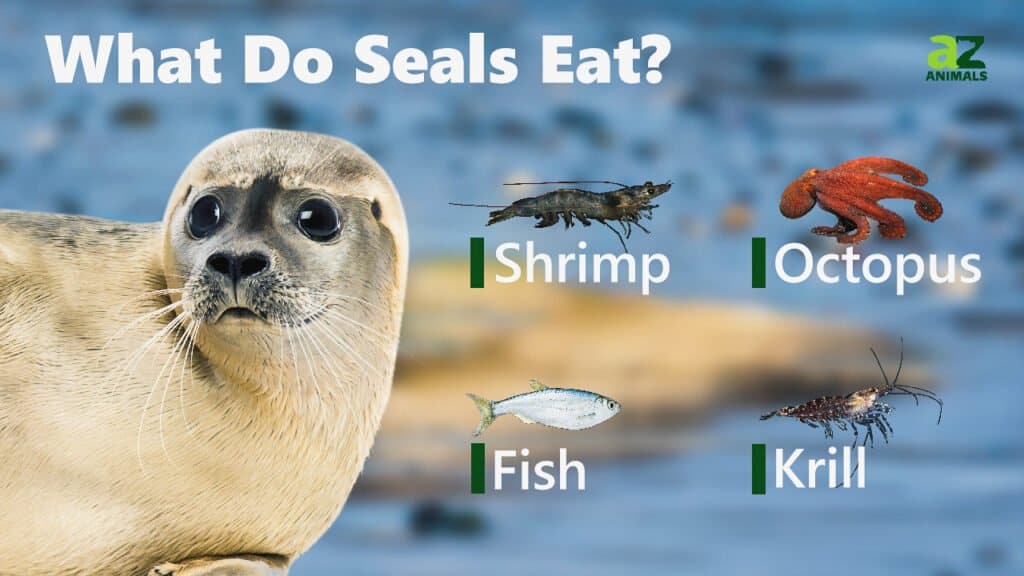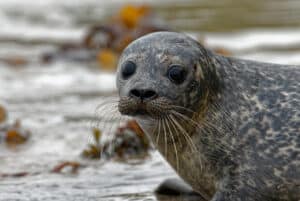Just a look at a seal’s skull gives you a hint as to what makes up its diet. If you didn’t know better, you’d think it was the skull of a wolf, with its fangs and carnassial teeth meant for grabbing and shearing meat. Indeed, seals are carnivores. They’re not only carnivores but are quite skilled and persistent hunters. The difference is that wolves hunt on the land while seals hunt in the ocean. To help them do this, nature has not only equipped them with fangs but flippers, torpedo-shaped bodies, and layers of blubber if they make their living in the colder seas.
Seals are members of the Pinnipedia order, which is divided into three families and about 34 species. Two include the true seals, the fur seals, and sea lions. The 10 foot long, one-ton walrus with its famous tusks make up a family of its own. Read on to learn what makes up the seal’s diet and how it gets its food.
What Foods Do Seals Eat?

As carnivores, seals eat aquatic animals, mostly fish. However, some seals have a surprisingly varied diet. The endangered New Zealand sea lion, for example, eats not only fish but squid and octopus and crustaceans such as shrimp. It will even eat other seals and has been known to catch and eat insects and seabirds.
The walrus appears to be an invertebrate specialist. It takes mollusks, marine worms, sea cucumbers, sea squirts, and other tunicates and soft coral. It hunts along the bottom of the sea and can find prey through its sensitive whiskers. It uses its flippers and blows jets of water into the seabed to clear it. When a walrus finds prey, it grips it with its lips and sucks the meat out of the shell. The walrus rarely eats seabirds and bits of other seals and might scavenge if it finds a dead whale.
The Antarctic fur seal’s diet is mostly krill, but they’ve been known to eat penguins. Harbor seals have been known to eat ducks, and gray seals have been known to eat harbor porpoises. These porpoises can grow to over six feet long and weigh 168 pounds, but grown gray seal bulls are larger. They can be over seven feet long and weigh 680 pounds.
How Do Seals Hunt Prey?

©iStock.com/Valery Kudryavtsev
Some seals, such as the California sea lion, hunt cooperatively with dolphins who can corral great schools of fish. Many seals range far and wide and dive deeply to hunt for prey. The Weddell seal can dive as deep as 1968.5 feet and stay submerged for an hour looking for prawns and other bottom feeders. Harbor seals can swim as far as 31 miles from their resting areas and stay out there for days looking for food.
Northern elephant seals swim as much as 13,000 miles through the ocean in search of food and don’t return to land until it’s time to reproduce and molt. Not only this, but they can dive to over 5000 feet and hold their breath for close to two hours. They also have several physical adaptations that allow them to conserve energy and oxygen while they’re diving.
The leopard seal has a good repertoire of hunting strategies. It stalks penguins along the edges of the ice where the bird lives. When the penguin comes into the water, the seal grabs its feet and shakes and bashes it to death. It then rips the animal into manageable pieces. Like the walrus, the leopard seal uses suction to eat small fish. When it hunts for krill, the leopard seal uses filter feeding. Its back teeth come together in a way that lets it strain krill from the ocean. This is also true of the crabeater seal. The crabeater seal, by the way, doesn’t eat crabs so much but specializes in krill.
The ribbon seal of the North Pacific Ocean have weaker fangs than some other seals, and they hunt their prey by piercing them with their teeth and swallowing them whole as opposed to tearing them to pieces.
Monk seals forage on the bottom of the sea and have been seen flipping over rocks to look for prey. Still, as fast swimmers they can pursue prey in open water.
A study of harbor seals revealed they participate in cooperative hunting, as do many other types of seals. Anywhere from 2-8 seals may hunt together. Findings were unable to prove that this style was more successful than individual hunting, however.
Some seals have different strategies depending on the time of day. The Baikal seal uses its eyes to search for fish during the day, while at night it uses touch to find crustaceans.
What Animals Eat Seals?
Seals only look cute. They are large and aggressive animals and don’t have too many predators, though humans have done a number on their numbers. Most seals are taken as pups or if they are sick or weakened. Animals that eat seals include:
- Humans
- Great White Sharks
- Other seals
- Killer whales
- Mako sharks
- Polar bears
- Arctic foxes
- Tiger sharks
- Galapagos shark
Up Next…
Intrigued? Let’s seal the deal with more pinniped facts!
- 10 Incredible Sea Lion Facts True socialites, sea lions are fascinating creatures who will talk your ear off!
- 10 Incredible Leopard Seal Facts Wait to you hear how these seals hunt penguins!
- 10 Incredible Elephant Seal Facts Find out why they are called “elephant” seals!
The photo featured at the top of this post is © Tarpan/Shutterstock.com
FAQs (Frequently Asked Questions)
What type of fish do seals eat?
The types of fish seals eat include:
• Patagonian toothfish
• Antarctic horsefish
• Dogfish
• Anchovies
• Herring
• Halibut
• Atlantic Argentine
• Redfish
• Pacific whiting
• Hake
• Wrasse
• Lampreys
• Rockfish
• Salmon
• Trout
• Icefish
• Skates
• Rays
• Mackerel
• Pollock
• Lanternfish
• Capelin
• Flatfish
• Shad
• Sea bass
• Eels
• Eelpout
• Golomyankas. Also called the Baikal oilfish, this is a type of sculpin endemic to Lake Baikal. Lake Baikal is home to Baikal seals, which are rare freshwater seals.
• Whitefish
• Antarctic silverfish
How much do seals eat in a day?
One rule of thumb is that a seal needs to eat about 4 to 6 percent of its weight every day, but how much a seal actually eats depends on whether it is active or sedentary. Seals who are breeding or molting don’t eat at all for long periods of time. A Weddell seal that is sedentary can eat about 22 pounds of food every day while a seal that is active can eat over 100 pounds a day. A grown Weddell seal can weigh between 880 and 1320 pounds. The harbor seal, which is small for a seal, needs 12 to 18 pounds every day.
The gray seal usually needs between 35 and 52 pounds every day, but as stated, a large gray seal can kill and eat a harbor porpoise. The huge elephant seal needs to chow down on 180 to 270 pounds of seafood daily while it’s at sea, for when it hauls out it will fast, often for weeks. This is because it can’t enter the water when it’s mating, fighting, giving birth, nursing a pup or shedding its skin, and the water is where the food is.
Thank you for reading! Have some feedback for us? Contact the AZ Animals editorial team.






